Chapter 8
Your Brand, Your Show
“All the world’s a stage, and all the men and women merely players.”
As You Like It
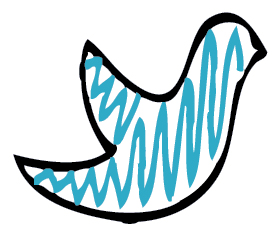
My parents often reminisced fondly about their childhood family gatherings around the fireplace on a Sunday evening. Glasses of warm milk in their hands and their tummies still full from lunchtime’s Sunday roast, as their parents tuned-in to the early evening’s line-up of entertainment on the radio.
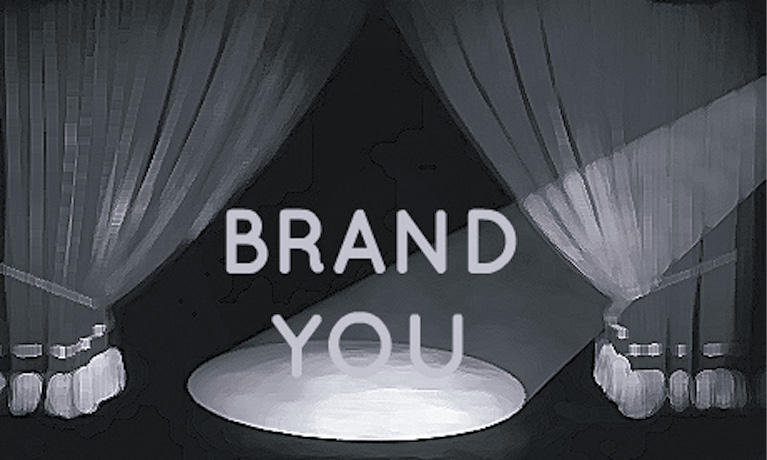 "
"
The popular shows of the time included Abbott and Costello, Burns and Allen, Easy Aces, and Ethel and Albert in the United States, and The Goon Show and Hancock’s Half Hour across the pond in England, where my parents both grew up.
“There was something special about the radio. Something about the listening,” my father told me. “It allowed us to use our imaginations to paint pictures. Television has deprived us of that gift.”
From the White House to the Moon
But the times they were a-changing, and the counterculture of the 1960s and 1970s saw the rapid invasion of a new form of media through the evolution of television networks and the types of program they were starting to present. By the turn of the swinging ’60s, television sets were becoming a commonplace addition in the home, and exciting new changes began taking place in program content and production techniques.
Millions of people were able to watch Martin Luther King, Jr.’s “I Have a Dream” speech, broadcast live in 1963 (see Figure 8-1), which marked a shift in the political use of television as a means of drawing the public’s attention to campaigns and causes. By the end of the ’60s, the dream reached lunar proportions as we gathered in front of our boxes to watch the first man walk on the moon. As children, we sang along with Big Bird and decorated our Christmas trees to the Muppets’ Christmas Carol.
Figure 8-1
A 2011 study by Visible Measures shows the viewer abandonment rates and number of seconds until abandonment of 40 million videos over 7 billion viewings.
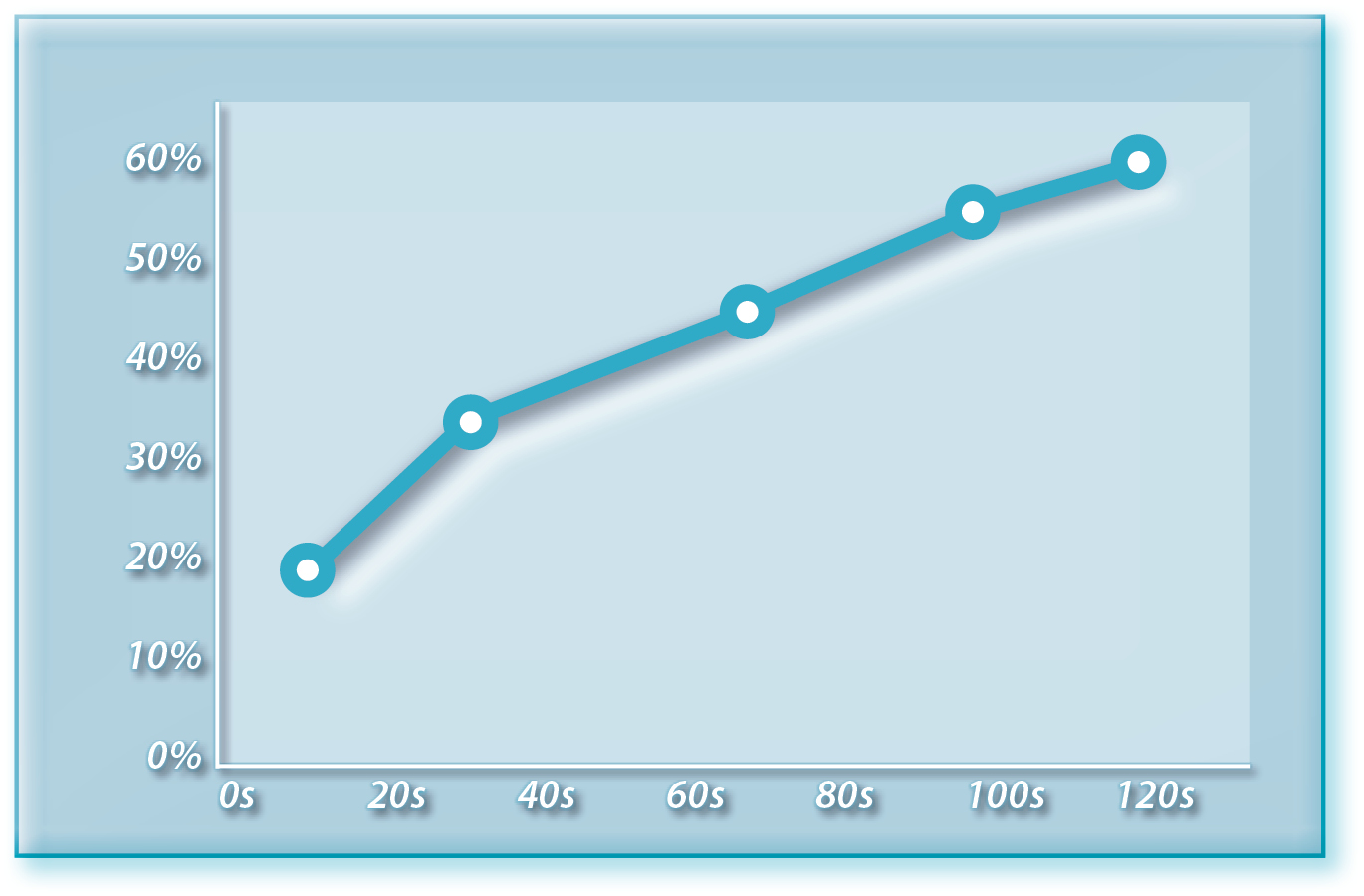
A Shift in Power
Then came the 1980s with the arrival of the video recorder, and suddenly the game changed yet again. Our media choices were extended, as we were no longer restricted to watching the clock to catch our favorite shows. Now we could record, rewind, fast-forward, and even watch our favorite clips in slow motion. We were empowered by a new ability to watch what we wanted when we wanted. Video stores opened in the thousands, where we could rent movies to share with friends and family at a time governed by us and us alone. Suddenly, the viewer was in control — and there was no going back!
The Incredible Shrinking Attention Span
This shift in power was intoxicating, but it also began a psychological shift in how we chose to deal with the growing number of media choices on offer. As the options slowly increased, our attention spans began to shrink.
Today, we require our education and entertainment, or edutainment as it’s recently been termed, in chunks. They need to grab our attention immediately to keep us hanging around.
And that’s not just my opinion. A 2011 study by research group Visible Measures found that, after watching an online video for just 60 seconds, 44.1 percent of viewers would have clicked away.
This phenomenon, known as viewer abandonment, is of intense interest to those who make today’s media or advertise in it. Visible Measures studied the abandonment rate of 40 million online videos over 7 billion viewings, as shown in Figure 8-1. Music videos had especially high rates of abandonment, as did videos slow to reach a punch-line. For example, a Budweiser video about a man humiliated while buying pornography lost almost 40 percent of viewers in the first 10 seconds.
From a Set-Top Box to a Streaming World
We live in a world today where we can access information, entertainment, and education almost anywhere, whether traveling on a bus downtown, strolling in the park, or passing time at the airport. We carry our content with us and it’s become pocket-size! We can flit between taking a call, writing an email, reading a text, and watching our favorite band play live on stage at Radio City Music Hall. With all these choices constantly available to us, it’s no wonder that our synapses have adapted to filter out any unwanted noise.
This need to filter our choices has led to another huge shift. According to the Associated Press, hundreds of thousands of viewers are ditching their monthly cable or satellite TV service in favor of streaming video. The AP examined cable and satellite companies’ quarterly returns and concluded that they had lost about 195,000 subscribers in the second quarter of 2011.
Interestingly, the study included Verizon and AT&T, which may be losing TV subscribers, but are equally gaining in mobile subscribers, again reinforcing the theory that we all need to be permanently connected to the content we choose to receive today. It reaffirms Dean Anthony Gratton’s theory of the Lawnmower Man Effect that I introduced in Chapter 2.
It All Leads to Twitter
It’s this sense of immediacy and the condensed edutainment potential that makes Twitter the perfect platform to launch your online brand “show.” (I use the word “show” because that’s exactly what it’s going to be!)
So, let’s take stock of everything you’ve learned so far in this book. By now you have gained a strong sense of your personal brand, you know how to identify and use the four types of tweets, and you are well on your way to building a great Twittertorial calendar.
Now, you’re going to use all these elements to transform your Twitter stream into your personal online show. A dazzling content feed that will keep your audience both entertained and educated, while it works around the clock to showcase brand “you”!
Building Your Brand from the Foundation Up
Your Twittertorial calendar already contains your foundation tweets (see Chapter 7), so let’s start with them. They might be quotes or links having edutainment value. Your first foundation tweet of the day marks the way forward for all the other types of tweet you need to insert to create your show. You should incorporate the four types of tweets in your stream that I introduced in Chapter 5 and ensure that your suggestion tweets (see Chapter 7) are curated with the most relevant content.
Mixing It Up
Where possible, and especially in the early days of building your brand on Twitter, try to keep to content that is related or specific to your field. But, just because your field is technical or maybe rooted in finance or industry, that doesn’t mean your tweets can’t be uplifting and even humorous at times. Remember that you’re using Twitter to set yourself apart by emotionally connecting with your followers, so choose a mix of content that will do just that.
Quotations
These are great show-fillers and can be planned in advance as foundation tweets. Many people search specifically for the hashtag #quote to find those gems worth retweeting each day, so ensure that the ones you pick best reflect your brand message.
Bear in mind that the quotes you choose don’t necessarily have to spell out your given field but can be relevant through their association with the passion you feel for them. For example, a sports coach might choose to tweet quotes such as “You can out-distance that which is running after you, but not what is running inside you. —Rwandan proverb” #quote #sports” or “I never had a policy; I have just tried to do my very best each and every day. —Abraham Lincoln” #quote #sports”
Both are relative in emotional association, in contrast to “The fewer rules a coach has, the fewer rules there are for players to break. —John Madden” #quote #sports” or “The breakfast of champions is not cereal, it’s the opposition. —Nick Seitz #quote #sports”
These are both sports-industry-specific and, therefore, also relevant.
Notice how I’ve incorporated the hashtags #quote and #sports at the end of each quotation tweet. This addition provides a further search tool for your audience and potential followers. I explain more about the power of hashtags in Chapter 10.
Bread, butter, and conversation
The tweets that include links to brand-related, dynamic articles, and posts are the bread and butter of your daily Twitter show and are what gives it substance and sticking power. I’ve already introduced some of the curation tools that can be used to locate your articles and posts for scheduling in your show and expand on these further in Part Four. Ultimately, you’re looking for posts that follow a particular theme, governed by a variety of factors such as time of year, upcoming events, or a leading item of news.
Your posts should, of course, include a healthy smattering of your own writing; those tweets I introduced in Chapter 7 as your brand anchors, supplemented by influential posts and articles from trusted sources.
You should also use the here and now to build unique, current content for your audience that’s engaging and entices a conversation. For example, a news story you’ve just heard on the radio or a song that you can’t get out of your head. Can you tie them into your brand message in some way?
Even if the connection is abstract, you can use it to start a conversation with your audience. For example, I woke up with the song “Price Tag” by Jessie J in my head a few weeks ago and the lyrics just wouldn’t leave me as I tried to write that day. I incorporated my frustration as a tweet in my show (see Figure 8-2). This resulted in numerous retweets and replies from followers, some who found the association humorous and others who had similar stories of irony to tell.
Figure 8-2
Use the here and now to build unique current content for your audience.

A picture paints a thousand tweets
Include photos, illustrations, infographics, and other images into your show on a daily basis to lift it to another, more exiting dimension. To add cohesion, find a way to keep a regular theme running through that occurs at the same time each day.
As someone who builds brands on Twitter, I try to find pictorial ways to humorously link the platform to everyday situations in life such as sleeping where, on one occasion, I posted a photograph of the perfect Twitter bed (see Figure 8-3).
Photography can also be used to add drama and depth to a tweet as shown in Figure 8-4. These make the tweets more memorable, and a good image is likely to be retweeted many times. Always be sure to give credit where credit’s due by including the image copyright and the originator’s Twitter handle if appropriate, which is another way of expanding on your quality connections.
Figure 8-3
I like to incorporate amusing but brand-relevant photos to provide humor for my audience.
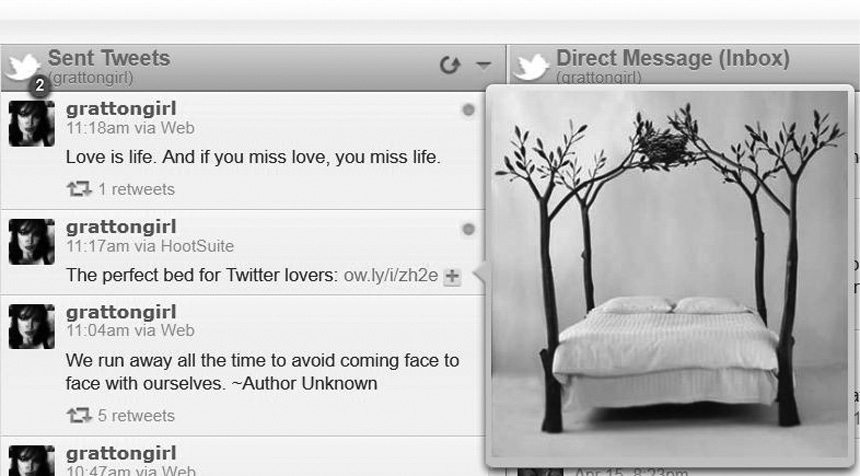
Figure 8-4
An example of how photography can be used to add drama to a tweeted statement or quotation.
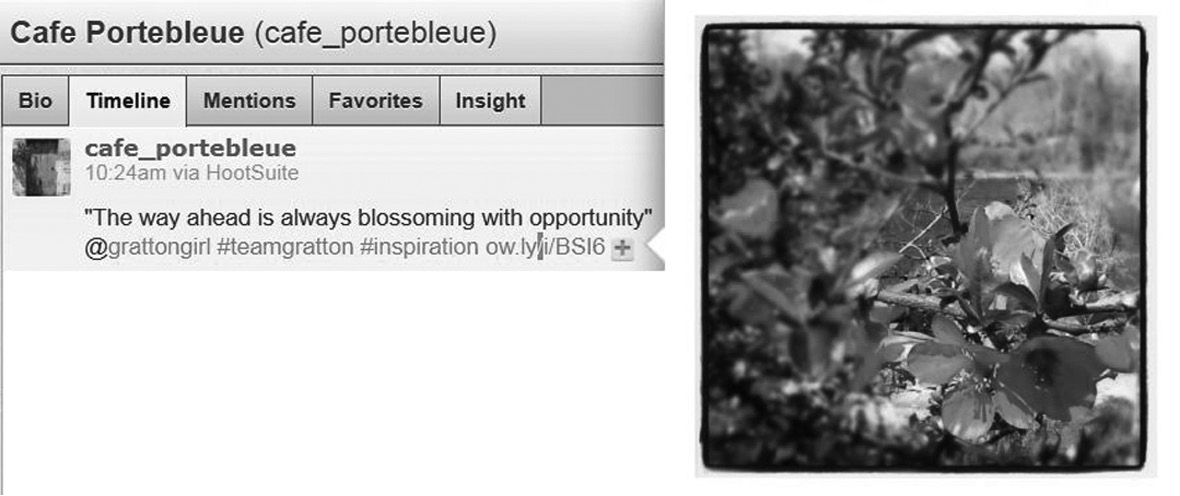
Incorporating great video content
Supporting your brand message through great content includes extending it to video. If you have your own YouTube (or similar) channel relating to your brand, you’re off to a flying start and can tweet links to its videos on a regular — perhaps daily — basis, depending on how extensive your library of content is. If you don’t yet have a YouTube channel for your brand, start an account and use it to source related video links that will translate into great tweeted content for your show.
As I mentioned earlier in this chapter, the media choices have grown exponentially from year to year and, as a result, our attention spans have shrunk dramatically. Bear this in mind when you choose video content for your brand show and keep the video to 120 seconds or less to avoid the high levels of viewer abandonment I described earlier. Use your judgment in selecting the videos with the most sticking power and those that are likely to go viral.
Don’t be afraid to retweet the videos everyone is talking about. They may not be your discovery, but they are the ones your followers will applaud you for including, and that they will be happy to watch and retweet again and again.
A great example of this is the recent Belgium-based TNT promo video, which quickly became viral on YouTube thanks to the thousands of overnight views it received and the way it spread like wildfire on Twitter. The secret of its stickiness is that you need to keep watching to see what happens next! It’s a hidden-camera-based promotion where a huge button was placed in a quiet square in a Belgium town with a sign hanging over it reading “Push to add drama” (see Figure 8-5). It goes without saying that, before long, someone did indeed push the button and found themselves surrounded by many acted-out scenes from various movies and drama series. The promotion was only a couple of minutes long, just perfect in terms of keeping viewer attention and creating maximum impact for the TNT brand.
Figure 8-5
TNT’s clever YouTube video had stickiness and quickly went viral.
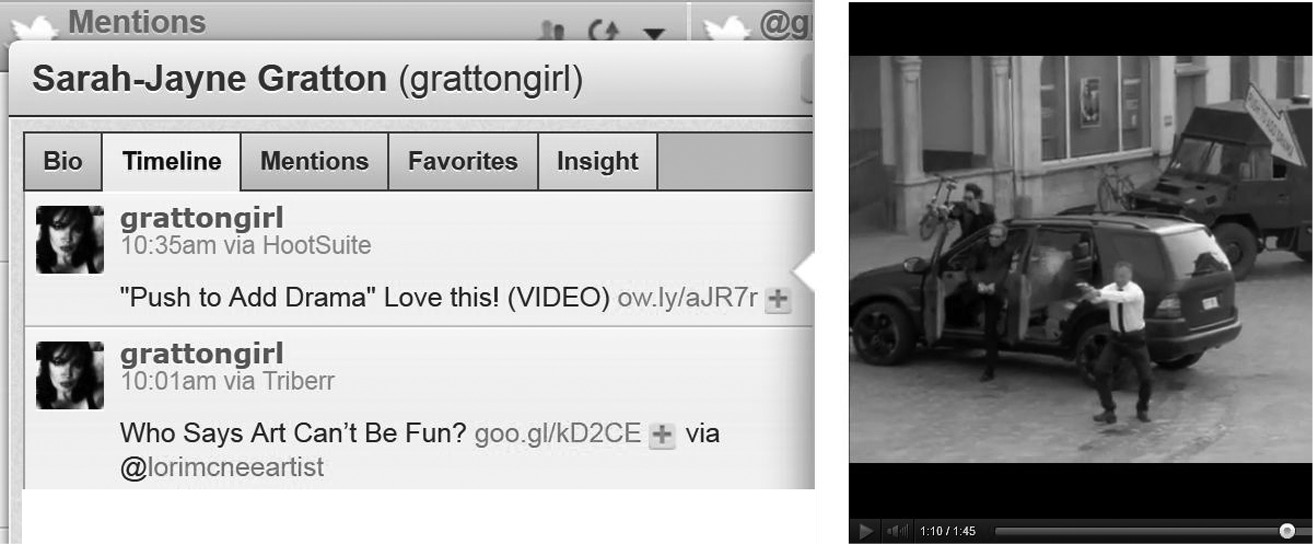
Planning Your Production Schedule
Take a look at Table 8-1 for an example of how I constructed a day’s personal brand-show content on Twitter. Each daily show is split into three four-hour blocks: Part 1, Part 2, and Part 3 (see the Schedule column) that I then repeated later in the day for reasons that I explain later in this chapter.
Using your Twittertorial calendar and your curation folders as a base for your schedule means that you’ve already done much of the work. The remainder should take no more than 60 to 90 minutes a day to complete, although you will need to set aside several hours a day for engaging with your followers through retweets, acknowledgements, replies, and thanks.
I also like to include random, off-the-cuff tweets, such as photographs I’ve taken at a particular time of day that my followers can relate to, or funny news items that have caught my attention. I occasionally invite my followers to take part in a caption competition, where I provide a free hour-long, one-on-one branding session as a prize for the most retweeted caption of the day. My own Twitter show runs seven days a week 365 days a year, although I limit the number of tweets I send over the weekends or holiday periods for obvious reasons.
Scheduling Your Tweets
If you want a 24-hour Twitter presence for your brand, it’s essential to automatically schedule at least some of your tweets each day. Many of the popular Twitter clients such as TweetDeck and HootSuite have built-in scheduling tools, as shown in Figure 8-6, or you can use an external service such as Buffer (see Figure 8-7) that I describe later in this chapter.
Try to schedule an even balance of tweets throughout the day, but don’t just post and forget about them! As I’ve mentioned, joining in the conversations you create and sharing them with others is a huge part of getting the most out of Twitter for your brand. Content may be king on Twitter, but engagement is undoubtedly his queen.
Figure 8-6
Many popular Twitter clients like HootSuite have a built-in scheduling tool.
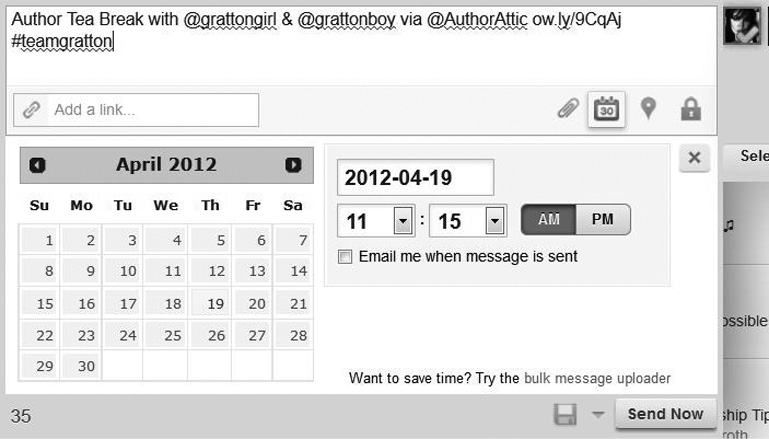
The schedule in Table 8-1 has blocked my daily show’s tweets into three four-hour segments. If you wanted your daily show to start at 7 a.m. each day, the first tweet in this block would be scheduled for 7 a.m., with the other tweets going out in semiregular intervals of 25 to 90 minutes, depending on the number of tweets you intend to send. Obviously, the more tweets you feature in your show, the less time you need to leave between them when scheduling.
It’s a good idea when starting out to experiment with the number of tweets you use in your show each day to find what works best for you and your audience in terms of planning, time management, and reciprocation. Also, bear in mind that you don’t want to schedule anything that is likely to need a high-level of immediate engagement when you’re not going to be on Twitter to participate in the conversation (overnight, for example), so let common sense prevail when making your scheduled content choices.
Table 8-1
Example of my daily Twitter personal brand show
|
Schedule |
Tweet |
Included Link or Attachment |
Type |
|
Part 1 |
Social Media Is a Contact Sport by @grattongirl |
(personal blog post link) |
Inform/Foundation Brand Anchor |
|
One Minute World News (video) @BBCWorld |
http://www.bbc.co.uk/news/video_and_audio/ |
Share+Inform/Foundation |
|
|
A revealing glimpse of Twitterphobia: |
http://yfrog.com/18kdwihj |
Foundation
|
|
|
Increasing Brand Awareness with #NFC technology and Social Media by @grattonboy #teamgratton |
http://ow.ly/6BYM4 |
Foundation Brand Anchor |
|
|
Part 2 |
“Don’t judge each day by the harvest you reap but by the seeds that you plant. ~Robert Louis Stevenson” #quote |
N/A |
Inform/Foundation |
|
Change is Good – But Don’t Forget to Ask Why. Great article from @tScottCase |
http://t.co/B8TJr320 |
Share+Inform Suggested
|
|
|
How to Take Your Brand From Zero to 100,000 by @grattongirl via @TheTop10Blog #branding |
http://vsb.li/xHZpss |
Inform+Foundation Brand Anchor |
|
|
Action Fraud - Protect Yourself Against Online Fraud (video) Watch and RT #devilsdetails |
http://ow.ly/ahVBm |
Inform+Engage Suggested |
|
|
Part 3 |
The future is always beginning now. ~Mark Strand #quote |
N/A |
Inform/Foundation |
|
How to Manage Your Money on the Web |
(personal blog post link) |
Inform/Foundation Brand Anchor |
|
|
Spread your message by “word of mouse” as well as word of mouth – Gratton and Gratton #teamgratton |
http://goo.gl/XFzVk |
Inform/Foundation Brand Anchor |
|
|
The @grattongirl Review is out! Top stories today via @ASuss49, @Hammerkit, P3Linz, @MichaelCrossann and @simorganphoto |
http://t.co/evi6zqJL |
Inform+Share Brand Anchor |
Making Twitter the Hub of Your Show
My example daily schedule shows how you can use Twitter as the central hub of your brand show to take your followers on a journey across all your social media platforms. It’s a use of social media that Dean and I coined in 2010 as cross-platform promotion (CPP). It involves the synergetic use of our various social media platforms to reinforce our brand message, albeit with a mixture of information, humor, and shared personal moments. It’s a cocktail of content that can be tailored to fit any personal brand statement, as I’ve shown in Chapter 7, and it’s one that will not only keep your existing followers coming back for more but will steadily bring a wealth of new quality followers to your fold.
The Wisdom of Repeat Tweets
Repeating tweets is a contentious subject, but more and more users have adopted Twitter as a promotional tool and are seeing the virtues and the sense behind repeat tweets.
It was Guy Kawasaki who first introduced me to the benefits of repeating my tweets over a 24-hour period. He likened his Twitter stream to the news stations that cycle their stories many times throughout the day. The stations repeat their segments to ensure that as many people as possible have the chance to catch their features, and the same can be said for the tweets you send out. After all, few people monitor Twitter all day, so by tweeting something only once, a significant number of your followers are highly unlikely to see it.
But let common sense prevail when it comes to repeating your tweets — and don’t overdo it!
Twitter frowns on duplicate tweets being sent from the same account within a four-hour period and so it may suspend these accounts due to the high probability of the tweets being spam. I generally repeat my tweets every six to eight hours due to the geographical variances between my followers and the differences in time zones (something that I explain further in Chapter 9). Repeating my tweets several times a day means that I can reach the maximum number of my followers, no matter where in the world they might be located. Using a tool such as the Buffer app to schedule your tweets based on those time zones you want to tweet within can attract the maximum amount of audience attention (see Figure 8-7).
Figure 8-7
Buffer finds and schedules the best times for your tweets to go out in your target time zone.
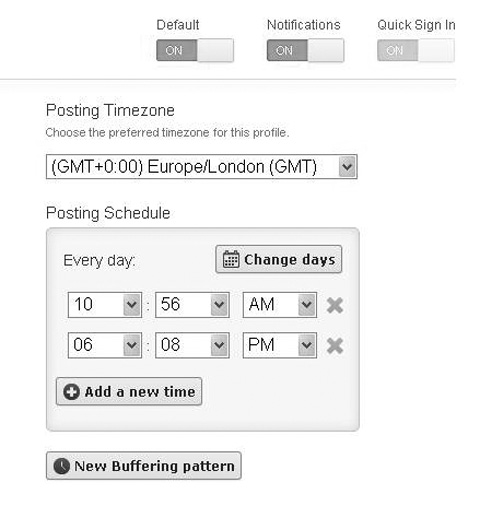
The equation is simple: Repeat your tweets to extend the number of people who will see them (your Twitter reach) and ultimately the number who will click through to any content such as an article or image URL. Increasing your reach increases the chance of your tweets being shared and retweeted (your Twitter amplification).
Above all, putting your personal brand Twitter content together should be a fun and enjoyable experience that you get to repeat on a daily basis, so put on your producer’s hat and make your experience an unmissable one.

